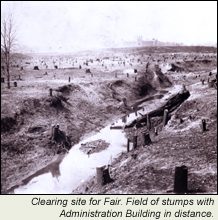|
 he
story behind the construction of the 1904 World’s Fair
is one of human perseverance—a testimony to the energy,
investment, and commitment of St. Louis’s citizens.
The Fair was a highly orchestrated event, with its designers
joining ranks with civic planners and an army of more than
10,000 laborers to transform over 1,200 acres of thickets
and swamps in Forest Park and Clayton into a grand landscape
filled with classically inspired buildings, waterways, gardens,
and avenues. The opening of the 1904 World’s Fair followed
several years of preparation that included the development
of surrounding neighborhoods, improvements to the city’s
water supply, and the clearing of parkland. he
story behind the construction of the 1904 World’s Fair
is one of human perseverance—a testimony to the energy,
investment, and commitment of St. Louis’s citizens.
The Fair was a highly orchestrated event, with its designers
joining ranks with civic planners and an army of more than
10,000 laborers to transform over 1,200 acres of thickets
and swamps in Forest Park and Clayton into a grand landscape
filled with classically inspired buildings, waterways, gardens,
and avenues. The opening of the 1904 World’s Fair followed
several years of preparation that included the development
of surrounding neighborhoods, improvements to the city’s
water supply, and the clearing of parkland.
 When
the Louisiana Purchase Exposition Company’s Executive
Committee selected Forest Park in late June 1901, many St.
Louisans were dismayed at the prospect of destroying the scenic
beauty of Forest Park for the coming Fair. The Exposition’s
publicity staffers were quick to defuse these concerns with
promises that the natural, rugged park would be “reborn”
into a more civilized space. When
the Louisiana Purchase Exposition Company’s Executive
Committee selected Forest Park in late June 1901, many St.
Louisans were dismayed at the prospect of destroying the scenic
beauty of Forest Park for the coming Fair. The Exposition’s
publicity staffers were quick to defuse these concerns with
promises that the natural, rugged park would be “reborn”
into a more civilized space.
The process of organizing, planning, constructing, and running
the Louisiana Purchase Exposition changed St. Louis. The transformation
of Forest Park from a wilderness of trees and thickets into
a showcase of the latest thinking in urban design required
an army of 10,000 workers who used cranes, tractors, horse
teams, survey kits, blasting equipment, and freight trains
to sculpt the land, lay sewer pipes and reroute the River
Des Peres.
The Department of Works straightened the meandering River
Des Peres and built a new covered wooden channel under the
main avenue of the Exposition to keep polluted water originating
north of Lindell Avenue away from the World’s Fair site.
Also constructed were new sewer lines under the park, which
were connected to St. Louis’s expanding sewer system.
George Kessler served as the chief landscape architect for
the Exposition. He worked in concert with his on-site supervisor,
D. W. C. Perry, to direct teams of surveyors who produced
topographical maps, coding the land with numbered wooden stakes
placed at 50-foot intervals. From these codes, Kessler directed
the immediate clearance of 200 acres of selected trees and
underbrush, mostly elms and sycamores, whose stumps had to
be blasted out with dynamite. His staff marked hundreds more
trees for transplantation and use on the Fair site and constructed
extensive greenhouses and horticultural beds on the Tesson
Tract to supply Kessler’s sculptural vision.
|
